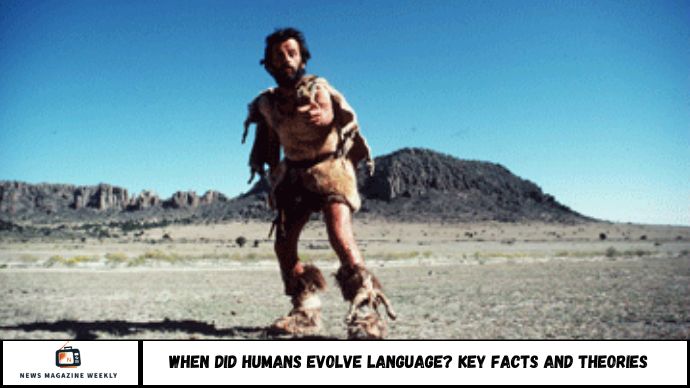When did humans evolve language and how did it shape our species? This article explores the timeline, theories, and key discoveries behind one of humanity’s most important traits. From prehistoric brain development to fossil evidence and modern linguistics, we break down what science reveals about the origin of human language.
From ordering coffee to explaining quantum physics, language shapes nearly every part of human life. With over 7,000 spoken languages around the world, it’s clear that language is one of our most powerful tools.
But the origin of language remains one of science’s greatest mysteries. While researchers agree it’s a uniquely human trait, the exact timeline of its evolution is still widely debated. In this article, we’ll explore the leading theories, key milestones, and the scientific evidence behind when and how humans evolved language.
How did humans go from grunts to grammar?
It’s one of the biggest mysteries in science: when and how did humans first develop language?
Language is what separates us from every other species on Earth. It allows us to collaborate, share knowledge, build cultures, and pass on stories. Yet, language itself leaves no direct fossil record.
Still, through careful research in anthropology, genetics, neurology, and archaeology, scientists have pieced together fascinating clues. This article explores the evolutionary timeline of human language, key milestones, and the most credible theories about how speech first emerged.
The Basics: What Is Language?
Before we dig into history, it’s important to define what we mean by “language.”
- Language involves structured communication using symbols or sounds.
- It includes syntax (grammar), semantics (meaning), and phonology (sounds).
- True language goes beyond gestures or calls—it’s open-ended, creative, and recursive.
Most animals communicate, but only humans use language in this complex, symbolic way.
Key Milestones in the Evolution of Human Language
1. Brain Evolution – Over 2 Million Years Ago
- Homo habilis, one of our early ancestors (2.4–1.4 million years ago), had a larger brain than apes but likely lacked true language.
- Broca’s area, a brain region essential for speech, is more developed in Homo erectus (~1.9 million years ago).
Insight: Brain changes were the first major step toward language—but structure alone doesn’t confirm speech.
2. Vocal Anatomy – Around 500,000 Years Ago
- Neanderthals had hyoid bones (a bone that supports the tongue) similar to ours, suggesting they could produce varied sounds.
- Recent studies also show Neanderthals had FOXP2, a gene linked to language in humans.
Fact: This suggests language capabilities may have been present at least 500,000 years ago in human relatives.
3. Symbolic Thought – Around 100,000–70,000 Years Ago
- Archaeological finds like cave paintings, beads, and burial rituals suggest symbolic thinking.
- These behaviors often rely on language to pass on ideas, beliefs, or identities.
Conclusion: Symbolic behavior points to the existence of fully developed language during this period.
4. The Great Leap – 70,000 Years Ago
- Often called the “Cognitive Revolution,” this era saw rapid cultural and technological advances.
- Tools, art, migration, and social structures exploded across the globe.
Theory: Many scholars believe this leap was triggered or enabled by the full development of language.
What Do Modern Studies Show?
Genetic Clues:
- The FOXP2 gene, found in both modern humans and Neanderthals, is strongly associated with speech and language ability.
- Mutations in this gene lead to severe language impairments in humans.
Brain Imaging:
- MRI studies show specific neural pathways (Broca’s and Wernicke’s areas) uniquely wired for processing language.
- These areas matured progressively across human evolution.
Statistical Insight:
A 2023 study from the Max Planck Institute for Evolutionary Anthropology suggests modern language may have fully emerged 70,000–100,000 years ago, aligning with archaeological records.
Key Takeaways
- Language likely evolved gradually, not suddenly.
- Multiple species, including Neanderthals, may have had speech-like communication.
- Modern human language, as we know it, probably appeared between 70,000–100,000 years ago.
- Brain and vocal tract evolution, symbolic behavior, and genetics all support this timeline.
FAQs
1. When did humans first start talking?
Probably between 100,000 and 70,000 years ago, during the rise of symbolic culture.
2. Did Neanderthals have language?
Evidence suggests they had some speech ability, but not as complex as ours.
3. What gene is linked to language evolution?
FOXP2 is the key gene linked to human language and speech development.
4. What makes human language unique?
Its complex grammar, infinite creativity, and use of symbols set it apart.
5. Did Homo erectus speak?
They had the brain size and anatomy for basic vocalization, but not full language.
6. Is language still evolving?
Yes. Language evolves constantly through slang, technology, and cultural shifts.
Conclusion
The evolution of language is a story that stretches back hundreds of thousands of years. From early hominins developing the brain structures for speech to modern humans expressing abstract ideas, language has been central to our survival and success.

